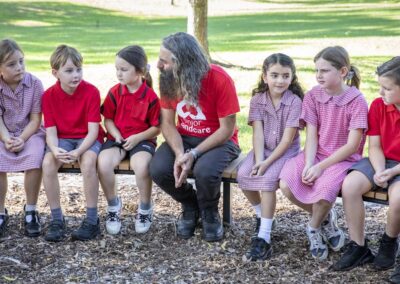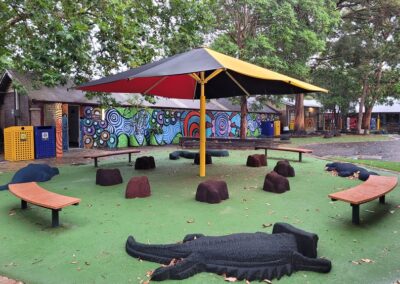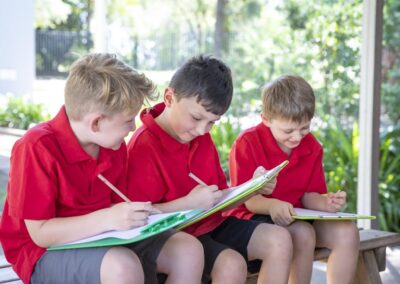
Creating a yarning circle: involving First Nations people
Time Allocation: 50 mins *
Activity Level: Moderate
Introduction
It is important to think about how you might work with the local First Nations community. Considerations include:
Try to invite and incorporate First Nations’ voices and opinions from the very start of the project so that it is carried out as respectively and cooperatively as possible throughout.
You can research service providers for gardens and landscaping on websites like Supply Nation, which is a site set up to promote First Nations businesses in many different fields.
Does your school have Aboriginal and Torres Strait Islander students who would like to get involved in the project? They may have an idea about the design. Maybe they would like to design other cultural elements for the yarning circle or incorporate a special animal, plant or artefact that is important to them.
This may also be a good opportunity to incorporate a traditional story of the area where you live, working with the local Custodians and Elders. Keep in mind, their time is precious and you will need to have budget set aside for their time and assistance. If you need to purchase any items, such as a talking stick, to help your yarning circle operate, make sure you let them know early so they have time to prepare or help source materials.
For educators, Landcare facilitators or students starting the community consultation journey who feel they may not know where to begin, our advice is start talking with the Aboriginal and Torres Strait Islander families connected to your school. There may be an Indigenous Learning Officer or similar type of staff member in or connected to your school who could give you advice about working with/connecting with families of Aboriginal and Torres Strait Islander students. If such a role does not exist at your school, then reach out directly to families of/other students. Even if they do not have exact information on how to set up a yarning circle themselves, they may be able to connect you with Elders and/or community members who do have skills and knowledge to help you.
* This will be dependent on drafting and other aspects of the task
Checklist
Instructions
 STEP 1
STEP 1
Introduction:
Begin this activity with an Acknowledgement of Country. By acknowledging the Land, you are also making a promise that you will recognise the Cultural practices of First Nations people.
Use the story above to provide background information.
Ask the students: “Why is it important that we work with First Nations people as much as possible for this project?”
Remind them that consulting with your local Elders and First Nations community is essential to building relationships. This is important to do throughout the process of setting up your yarning circle.
Creating a yarning circle is also a good opportunity to invite an Elder to speak at your school or to your group on regular occasions.
 STEP 2
STEP 2
Identify learning needs:
You may also like to reach out or find contacts in your local First Nations community. You could speak to parents of First Nations students, speak to the Indigenous Learning Officer at your school and/or your local Land Council or Landcare group.
Alternatively use the interactive AIATSIS Map of Indigenous Australia.
As a group, find out ‘Whose Country am I on?’
Consider engaging a First Nations artist or First Nations business to be part of your project (such as landscapers, garden designers or nurseries, which are great places to source your plants and to help out with knowledge about how to grow and use them).
 STEP 3
STEP 3
Investigate opportunities:
As a group, discuss how your project could be improved by working with First Nations people.
There are many elements that you may wish to include, for example:
- Commission a local First Nations artist to work with you to create a Cultural art piece or installation.
- Create an Indigenous plant use garden and work with local Elders to develop signs that include appropriate plant use information.
- Design your yarning circle to include important elements to the local First Nations peoples group.
If you are interested in using an Aboriginal or Torres Strait Islander name or word, story or artwork, it is important to request permission and consult with your local Traditional Owners. Refer to the Educator Notes for more information.
 Step 4
Step 4
Make a project plan:
Compile a list of the different stages of the project.
Discuss how you could involve First Nations people at each stage of the project. Note: all stages of this project have the potential for First Nations involvement, input and participation.
Your students will probably have a lot of questions at this point.
As a group, identify what questions could be answered by First Nations people.
Compile this list and add it to the children’s ideas of how you might involve First Nations groups in your project.
Present this list to School Council/Leadership.
Extension Activity
Language in your area: research First Nations words and their meanings such as ‘welcome’ that you can incorporate into your yarning circle.
Investigate Indigenous plants in your area and make a plan to include these in and around your yarning circle space. If you already have some of these plants growing in the area, investigate how First Nations people use these.